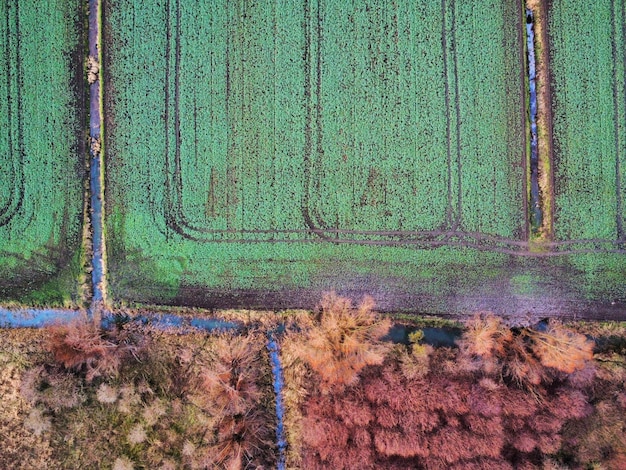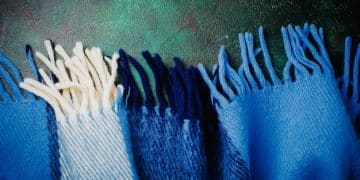Sustainable Fabrics 2025: The Future of US Fashion is Here

Sustainable fabrics are poised to revolutionize the US fashion industry by 2025, driven by increasing consumer demand, technological advancements, and a growing awareness of environmental impact, signaling a significant shift towards eco-friendly practices.
Are sustainable fabrics the future of US fashion? A deep dive into 2025 trends reveals a landscape ripe for transformation. The fashion industry, long criticized for its environmental impact, is on the cusp of embracing eco-friendly alternatives. What does this shift mean for designers, consumers, and the planet?
The Rise of Eco-Conscious Consumers
The fashion industry is undergoing a seismic shift, largely influenced by the rise of eco-conscious consumers. These individuals are not only aware of the environmental impact of their purchasing decisions but are actively seeking out sustainable alternatives. This growing demand is forcing brands to rethink their supply chains and embrace eco-friendly practices.
With increased access to information, consumers are becoming more educated about the harmful effects of fast fashion. They are learning about the water pollution, carbon emissions, and labor abuses associated with traditional textile production. As a result, they are demanding transparency and accountability from brands.
Transparency and Traceability
Transparency is no longer a luxury; it’s a necessity. Consumers want to know where their clothes come from and how they are made. Brands that can provide detailed information about their supply chains are gaining a competitive edge. Traceability, the ability to track a garment from raw material to finished product, is becoming increasingly important.
The Power of Social Media
Social media has played a crucial role in raising awareness about sustainable fashion. Influencers and activists are using platforms like Instagram and TikTok to educate consumers and hold brands accountable. Hashtags like #SustainableFashion and #EthicalFashion are trending, creating a community of like-minded individuals who are passionate about making a difference.

- Demand for Eco-Friendly Products: Consumers are actively seeking out products made from sustainable materials, driving market demand for eco-friendly textiles.
- Increased Awareness: Social media and educational campaigns have significantly raised awareness about the environmental and social impact of fashion.
- Influence of Millennials and Gen Z: Younger generations are particularly concerned about sustainability and are willing to pay more for ethical and eco-friendly products.
- Brand Accountability: Consumers are holding brands accountable for their environmental practices and demanding transparency in supply chains.
The rise of eco-conscious consumers is reshaping the fashion industry. Brands that prioritize sustainability are not only meeting consumer demand but also contributing to a healthier planet.
Innovative Sustainable Fabrics to Watch
The quest for sustainability has driven innovation in fabric technology, leading to the development of remarkable materials that minimize environmental impact. These fabrics, sourced from diverse and often unexpected origins, offer promising alternatives to conventional textiles.
Sustainable fabrics are not only environmentally friendly but also offer unique properties like enhanced durability, breathability, and comfort. The adoption of these materials marks a significant step towards a more sustainable and responsible fashion industry.
Recycled Materials
Recycled materials, such as recycled polyester (rPET) and recycled cotton, are gaining prominence. rPET is made from recycled plastic bottles, reducing landfill waste and the need for virgin polyester production. Recycled cotton, sourced from pre- or post-consumer waste, conserves water and reduces pesticide use.
Plant-Based Fabrics
Plant-based fabrics, including organic cotton, hemp, linen, and Tencel (lyocell), are favored for their renewability and biodegradability. Organic cotton is grown without synthetic pesticides or fertilizers, while hemp and linen require minimal water and pesticides. Tencel, derived from sustainably sourced wood pulp, is produced in a closed-loop process that minimizes waste and water usage.

- rPET (Recycled Polyester): Made from recycled plastic bottles, reducing waste and the need for virgin polyester.
- Organic Cotton: Grown without synthetic pesticides or fertilizers, promoting soil health and biodiversity.
- Hemp: Requires minimal water and pesticides, making it a highly sustainable crop.
- Tencel (Lyocell): Derived from sustainably sourced wood pulp, produced in a closed-loop process.
The innovation in sustainable fabrics is paving the way for a more eco-friendly fashion industry. By embracing these materials, brands can significantly reduce their environmental footprint and contribute to a more sustainable future.
Government Regulations and Incentives
Government policies play a critical role in promoting sustainable practices within the fashion industry. Regulations and incentives can drive the adoption of eco-friendly materials and processes, ensuring that sustainability is not just a trend but a mandated standard.
Governments are increasingly recognizing the need to address the environmental impact of fashion. By implementing supportive policies, they can encourage brands to invest in sustainable technologies and reduce their carbon footprint.
Extended Producer Responsibility (EPR)
EPR schemes hold producers responsible for the end-of-life management of their products. This encourages brands to design products that are durable, recyclable, and easy to repair. EPR can also incentivize the use of sustainable materials and reduce waste.
Tax Incentives and Subsidies
Tax incentives and subsidies can make sustainable practices more economically viable for businesses. Governments can offer tax breaks for companies that use sustainable materials or invest in eco-friendly technologies. Subsidies can also support research and development of innovative sustainable fabrics.
Government regulations and incentives are essential for creating a level playing field and driving systemic change in the fashion industry. By implementing supportive policies, governments can accelerate the transition towards a more sustainable future.
The Role of Technology in Sustainable Fabric Production
Technology is revolutionizing the production of sustainable fabrics, offering innovative solutions to minimize environmental impact and enhance efficiency. From advanced recycling techniques to eco-friendly dyeing processes, technology is driving the future of sustainable fashion.
The integration of technology into fabric production not only reduces environmental harm but also improves the quality and performance of sustainable materials. These advancements are making eco-friendly fabrics more appealing to both brands and consumers.
Waterless Dyeing
Traditional dyeing processes consume vast amounts of water and can release harmful chemicals into the environment. Waterless dyeing technologies, such as air dyeing and foam dyeing, significantly reduce water consumption and eliminate the need for toxic chemicals.
3D Printing
3D printing offers the potential to create customized garments with minimal waste. By printing directly onto sustainable fabrics, designers can reduce fabric scraps and create unique, personalized pieces. This technology also allows for on-demand production, reducing the need for large inventories.
- Waterless Dyeing: Reduces water consumption and eliminates the use of toxic chemicals in the dyeing process.
- 3D Printing: Creates customized garments with minimal waste, enabling on-demand production.
- Blockchain Technology: Enhances transparency and traceability in the supply chain, ensuring ethical sourcing and production.
Technology is playing a transformative role in sustainable fabric production. By embracing these innovations, the fashion industry can move towards more circular and eco-friendly practices.
Challenges and Opportunities in Adopting Sustainable Fabrics
While the shift towards sustainable fabrics presents numerous opportunities, it also poses significant challenges. Overcoming these hurdles is essential for realizing the full potential of sustainable fashion and creating a more responsible industry.
The adoption of sustainable fabrics requires a collaborative effort from brands, consumers, and policymakers. By addressing the challenges and capitalizing on the opportunities, the fashion industry can pave the way for a more sustainable future.
Cost Considerations
Sustainable fabrics often come with a higher price tag compared to conventional materials. This can be a barrier for brands, particularly those operating in the fast-fashion sector. However, as demand for sustainable fabrics increases, production costs are likely to decrease, making them more accessible.
Scalability
Scaling up the production of sustainable fabrics to meet the demands of the global fashion industry is a significant challenge. Limited availability of raw materials and infrastructure constraints can hinder scalability. Investing in research and development and expanding production capacity is crucial for overcoming this challenge.
Addressing these challenges requires a concerted effort from all stakeholders. By working together, the fashion industry can transform the challenges into opportunities and accelerate the transition towards a more sustainable future.
Looking Ahead: Sustainable Fabrics in US Fashion by 2025
The future of US fashion is inextricably linked to the adoption of sustainable fabrics. By 2025, we can expect to see significant advancements in sustainable fabric technology, increased consumer demand, and more stringent government regulations.
The transition towards sustainable fabrics is not just a trend; it’s a fundamental shift in the way fashion is produced and consumed. By embracing sustainability, the US fashion industry can lead the way in creating a more responsible and eco-friendly future.
Increased Adoption of Sustainable Practices
By 2025, more brands will integrate sustainable practices into their operations, from sourcing sustainable materials to implementing circular economy principles. This will result in a significant reduction in the environmental impact of the fashion industry.
Collaboration and Innovation
Collaboration between brands, researchers, and technology providers will drive innovation in sustainable fabric technology. This will lead to the development of new and improved sustainable materials that are both environmentally friendly and high-performing.
- Greater Transparency: Brands will provide more detailed information about their supply chains, allowing consumers to make informed purchasing decisions.
- Circular Economy: The fashion industry will embrace circular economy principles, such as product life cycle extension and textile recycling.
- Technological Advancements: New technologies will emerge, further reducing the environmental impact of fabric production.
The future of US fashion is bright, with sustainable fabrics at the forefront of innovation and change. By embracing sustainability, the industry can create a more responsible and eco-friendly future for all.
| Key Point | Brief Description |
|---|---|
| 🌱 Eco-Conscious Consumers | Driving demand for sustainable fashion and transparency. |
| ♻️ Innovative Fabrics | Recycled materials and plant-based options leading the way. |
| 🏛️ Government Support | Regulations and incentives promoting eco-friendly practices. |
| 🔬 Technology’s Role | Revolutionizing fabric production with advanced solutions. |
FAQ
▼
Sustainable fabrics are textiles produced using eco-friendly materials and processes. They aim to minimize environmental impact by reducing water consumption, carbon emissions, and waste.
▼
Sustainable fashion reduces the negative environmental and social impacts of the fashion industry. It promotes ethical labor practices, conserves resources, and reduces pollution.
▼
Examples include organic cotton, recycled polyester (rPET), hemp, linen, and Tencel (lyocell). These materials have lower environmental footprints compared to conventional textiles.
▼
Consumers can support sustainable fashion by buying from brands that prioritize ethical and eco-friendly practices, choosing sustainable materials, and extending the life of their clothes.
▼
Technology enables innovative solutions like waterless dyeing, 3D printing, and blockchain to enhance transparency and reduce the environmental impact of fabric production.
Conclusion
As we look towards 2025, the integration of sustainable fabrics into US fashion is not just a trend but a necessary evolution. With increasing consumer awareness, technological advancements, and supportive government policies, the fashion industry is poised to embrace a more responsible and eco-friendly future. By prioritizing sustainability, brands can not only meet the demands of eco-conscious consumers but also contribute to a healthier planet for generations to come.





